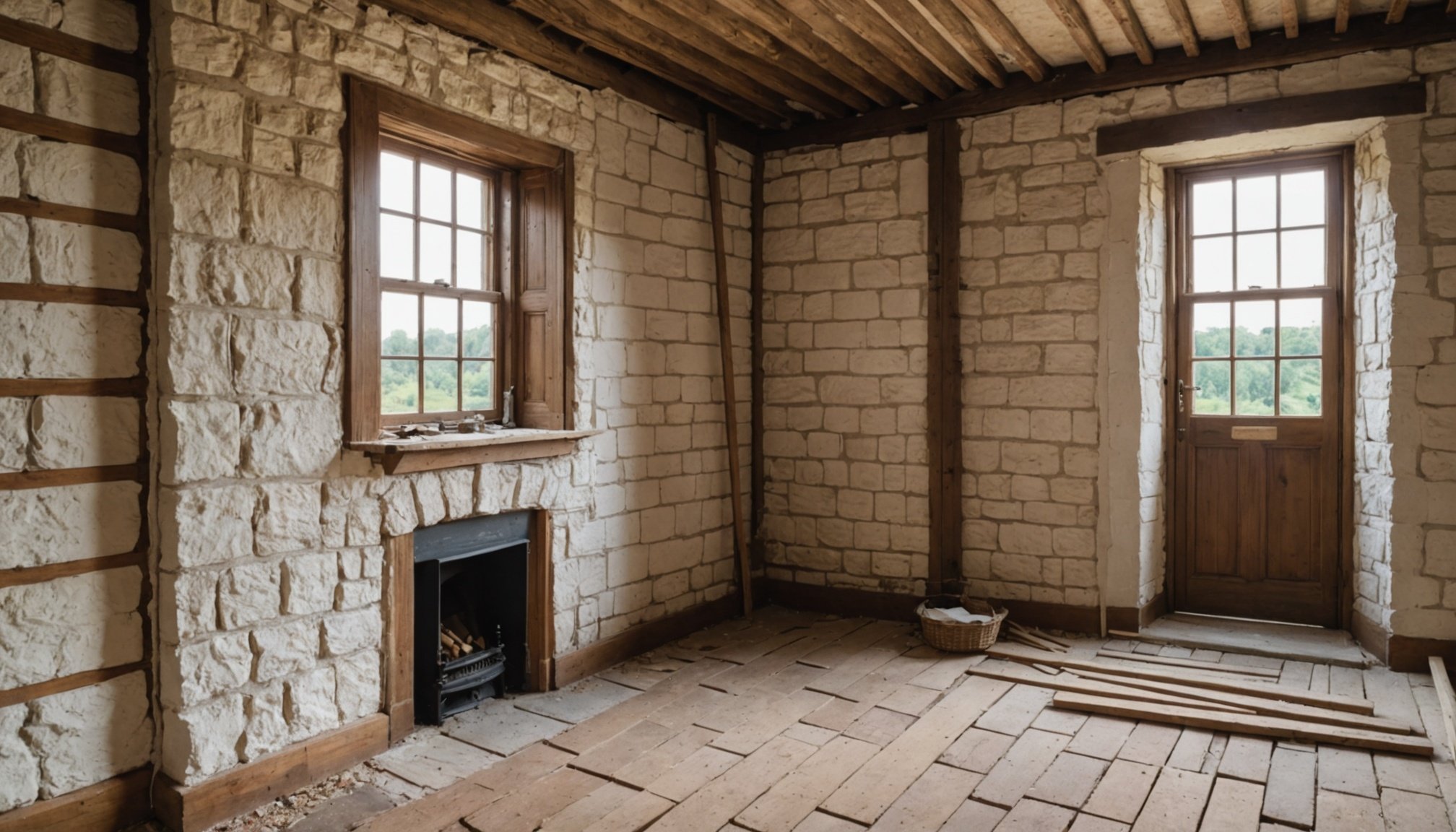Understanding Heritage Homes and Insulation Needs
Heritage homes boast a unique charm, rich with historical aesthetics that owners often wish to preserve. However, insulating these homes to enhance energy efficiency presents unique challenges. The key is balancing preserving historical elements with modern insulation needs.
Heritage properties frequently face issues like draughts due to older window styles and single-wall constructions that lack adequate insulation. These factors contribute to significant heat loss, affecting home comfort and increasing energy costs. Thus, determining effective insulation solutions without altering the building’s character is paramount.
Sujet a lire : Top Eco-Friendly Building Materials for Sustainable Small Home Extensions in the UK
When considering insulation modifications, a comprehensive understanding of regulatory considerations is crucial. Heritage homes usually fall under specific protection laws that limit alterations to their structure and appearance. As such, any insulation work must comply with local regulations, often requiring permission from heritage conservation authorities.
To navigate these challenges, several approaches can be adopted. For instance, homeowners might opt for internal wall insulation, which avoids altering external façades, or secondary glazing that retains original window styles while improving thermal performance.
A lire en complément : How do you determine the ideal placement for smoke detectors in a UK semi-detached house?
Improving energy efficiency in heritage homes doesn’t merely involve insulating walls. It requires a nuanced approach that respects the architectural integrity of these structures. In doing so, heritage property owners can enjoy the beauty and historical significance of their homes without compromising on comfort and efficiency.
Overview of Eco-Friendly Insulation Materials
Choosing eco-friendly insulation materials can play a significant role in the sustainability and energy efficiency of a building. These sustainable materials offer an excellent alternative to conventional insulation types, providing environmental benefits and enhancing the building’s overall performance.
Sheep Wool Insulation
Sheep wool is an exceptional choice for heritage homes, offering numerous advantages. One of its most remarkable properties is its ability to provide superior thermal performance. This means it helps maintain a steady indoor temperature, reducing the need for artificial heating and cooling. Additionally, sheep wool has excellent moisture regulation properties, which prevents mold and enhances indoor air quality. Its natural ability to absorb moisture without losing its insulative properties makes it ideal for various climates.
When considering installation, it’s crucial to note that sheep wool is incredibly easy to work with – its flexibility and natural resilience mean it fits snugly into cavities without the need for complex equipment or techniques. Moreover, it is naturally flame-retardant, adding an extra layer of safety to your property. Using sheep wool insulation is an effective way to contribute to a more sustainable environment while preserving the legacy and integrity of heritage homes.
Energy Efficiency Benefits of Eco-Friendly Insulation
Eco-friendly insulation significantly enhances energy efficiency in buildings. This sustainable choice reduces energy consumption by maintaining desirable indoor temperatures, making heating and cooling systems work more effectively. In heritage homes, this type of insulation can be particularly beneficial. Traditional structures often suffer from poor thermal performance, leading to high energy demands. With eco-friendly insulation, these homes can drastically curtail heating and cooling requirements, thus preserving their historic character while boosting energy performance.
The adoption of eco-friendly insulation also leads to substantial cost savings over time. By reducing reliance on heating and cooling systems, utility bills are lowered. Additionally, the reduced wear on these systems extends their lifespan, further slashing repair and replacement costs. Heritage homes can benefit tremendously; the improved insulation helps minimise temperature fluctuations, reducing stress on existing HVAC systems and enhancing their longevity.
Overall, eco-friendly insulation not only supports energy efficiency but also ensures long-term economic advantages. While it may require an initial investment, the resulting savings make it a wise choice for homeowners keen on preserving architectural heritage while efficiently managing energy consumption. Embracing eco-friendly insulation solutions is a step forward in sustainable living, marrying the charm of historic homes with modern efficiency benefits.
Installation Tips for Heritage Homes
Heritage homes, with their timeless architecture, require a delicate approach when it comes to insulation installation. The key is to improve efficiency while preserving historical integrity.
Assessing Existing Structures
Before embarking on insulation installation, it is crucial to conduct a thorough assessment of the existing structures. This helps in identifying the precise areas that require insulation and highlights any potential obstacles, such as hidden voids or delicate materials. Collaborating with specialists familiar with heritage restorations ensures that these assessments are done accurately and with respect for the historical aspects of the home.
Techniques for Effective Installation
Choosing the right techniques for insulation in heritage homes is essential. Best practices often involve using materials that are sympathetic to the home’s original design, and applying insulation in a way that minimizes changes to the building’s fabric. Efforts should be made to ensure local regulations are met, which often have specific guidelines for historical properties. Tips include:
- Using breathable materials that don’t trap moisture, preserving wood structures.
- Employing minimally invasive methods to protect ornate detailing.
- Considering insulation installation in attic spaces or under floors where it remains hidden.
By following these guidelines, not only is the energy efficiency of heritage homes improved, but their historical value is also safeguarded for future generations.
Case Studies and Success Stories
When it comes to heritage home renovations, numerous case studies highlight the triumphs and challenges of integrating eco-friendly insulation. A prime example in the UK includes projects that embraced sustainable solutions while preserving architectural integrity. In one standout case, a historic manor in Sussex underwent a transformation that respected its original aesthetics while bolstering energy efficiency. The success of these insulation projects is often measured by the substantial reduction in energy consumption and enhanced thermal comfort.
These achievements offer invaluable lessons learned. A key takeaway is the importance of selecting insulation materials that complement the building’s heritage. Technical assessments preceding the installation have been proven essential, ensuring compatibility and maximizing the project’s success.
For those involved in similar endeavors, there are best practices identified from these projects. It is crucial to balance modern needs with traditional craftsmanship, often requiring custom solutions where standard measures fall short. In terms of data on energy efficiency, studies indicate that post-installation, heritage homes can see energy savings of up to 30%. These statistics are a testament to the effectiveness of thoughtful, environment-friendly interventions.
Through these successful insulation projects, other property owners can gain inspiration and confidence, knowing the potential for progress in conservation and sustainability.
Regulatory Compliance and Available Grants
When it comes to modifying heritage homes in the UK, conservation regulations can often present unique challenges. These rules ensure that developments maintain the historical and architectural significance of such properties. Navigating these regulations calls for a thorough understanding of what changes are permissible.
Adapting these properties for energy efficiency without compromising their heritage value is possible. Homeowners can benefit from various renovation grants designed to support eco-friendly adjustments. These grants can significantly mitigate the costs associated with improving energy efficiency in homes that fall under heritage protection. For instance, the Green Deal Finance and the Local Authority Delivery Scheme are options to explore. Each comes with specific requirements, but the potential savings and environmental benefits make them worth investigating.
Understanding how to operate within the regulatory landscape is key to successful heritage home insulation projects. Here are a few steps to consider:
- Conduct detailed research on applicable conservation regulations specific to your property.
- Contact authorities or heritage bodies for guidance on acceptable modifications.
- Identify available funding for heritage projects tailored to eco-friendly renovations.
Following these steps not only enriches one’s knowledge but also equips homeowners with practical means to enhance their property’s efficiency while honouring its heritage status.






